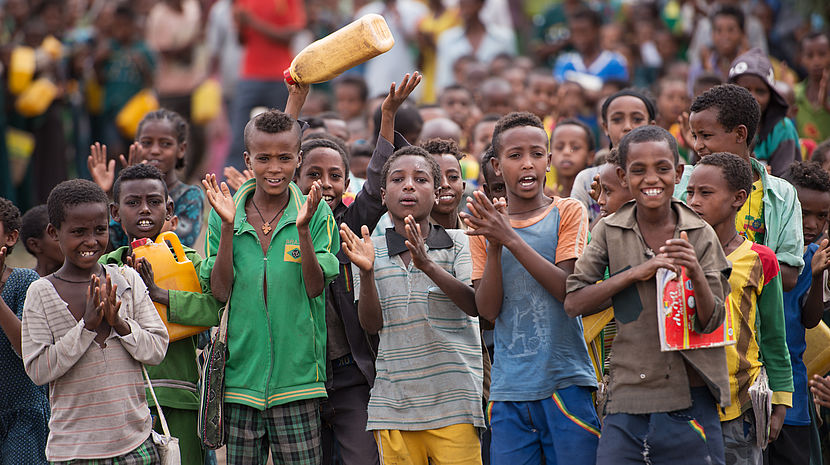22.09.2015 We are all in the same pot: the importance of disability indicators

Today, the Republic of Korea generously hosted a side event focused on disability indicators. The event was timely because of the second IAEG-SDGs meeting in Bangkok (26-28 October) that will discuss the indicator framework for the monitoring of the Goals and targets of the 2030 Agenda for Sustainable Development at the global level, and to support its implementation. Persons with disabilities must be included in this framework to ensure they are not left behind in the new global agenda.
The event was collaborative with support and organization from the International Disability Alliance (IDA), the International Disability and Development Consortium (IDDC), Sightsavers, UNICEF, UNDESA, and the Missions of the Republic of Korea, Antigua and Barbuda, and Australia.
Member States and groups in attendance included Brazil, Argentina, Finland, Norway, Spain, Australia, New Zealand, Canada, Germany, Singapore, Palau, the Bahamas, Pakistan, Jordan, the EU, and CARICOM.
Presenters included Vladimir Cuk, IDA; Dominic Haslam, Sightsavers; Ambassador Aubrey Webson, Antigua and Barbuda; Maria Martinho, UNDESA; Rosangela Berman Bieler, UNICEF, and Ambassador Hahn, Republic of Korea. The presentations were concise, succinct and provided effective examples of disability data collection.
The Disability Indicators: SDG Advocacy Toolkit – developed in partnership by the UN, IDA and IDDC – was launched at the side event. Broadly, it calls to disaggregate all relevant targets by disability and to use the following disability/persons with disabilities indicators in relation to the Sustainable Development Goals and targets.
Goal 1: End poverty in all its forms everywhere
1.1 – Percentage of persons with disabilities below $1.25 (PPP) per day
1.3 & 10.4 – Percentage of persons with disabilities covered by social protection, or percentage of persons with disabilities receiving benefits
1.5 & 11.5 – Percentage of deaths from persons with disabilities among all deaths due to disasters
– Percentage of injured/missing/ relocated/evacuated persons with disabilities among all injured/missing/ relocated/evacuated due to disasters
Goal 3: Ensure healthy lives and promote well-being for all at all ages
3.2 – Under-five mortality rate for children with disabilities
3.8 – Percentage of persons with disabilities receiving needed health services
– Percentage of persons with disabilities receiving needed assistive technologies
– Proportion of households with persons with disabilities facing catastrophic health expenditure
– Proportion of households with persons with disabilities facing impoverishing health expenditure
Goal 4: Ensure inclusive and equitable quality education and promote lifelong learning opportunities for all
4.5 – Primary and secondary school net attendance ratio for children with disabilities
– Percentage of teachers in service who have received in-service training in the last 12 months to teach students with special educational needs
4.a – Percentage of schools (primary, lower and upper secondary) with adapted infrastructure and materials for students with disabilities
Goal 5: Achieve gender equality and empower all women and girls
5.2 – Percentage of women and girls with disabilities subjected to physical and/or sexual violence
5.6 – Percentage of women and girls who make decisions about their own sexual and reproductive health and reproductive rights, disaggregated for persons with/without disabilities
Goal 6: Ensure availability and sustainable management of water and sanitation for all
6.1 – Percentage of population using safely managed drinking water services, disaggregated for persons with/without disabilities
6.2 – Percentage of population using safely managed sanitation services, disaggregated for persons with/without disabilities
Goal 8: Promote sustained, inclusive and sustainable economic growth, full and productive employment and decent work for all
8.5 – Unemployment rate, disaggregated for persons with/without disabilities
Goal 10: Reduce inequality within and among countries
10.2
– Percentage of positions in public institutions (national and local legislatures, public service, and judiciary) held by persons with disabilities
– Voting turnout as a share of voting-age population disaggregated by disability
– Percentage of government websites which meet the ISO/IEC 40500:2012 of accessibility for Web content
– Percentage of population owning a mobile phone, disaggregated for persons with/without disabilities
– Percentage of population with disabilities with internet access, disaggregated for persons with/without disabilities
Goal 11: Make cities and human settlements inclusive, safe, resilient and sustainable
11.2 – Percentage of public transport vehicles meeting the minimum national standards for accessibility by persons with disabilities
11.7 – Percentage of public buildings meeting the ISO 21542:2011 standards on accessibility and usability of the built environment
– Percentage of public green spaces (parks and recreational facilities) meeting the minimum national standards for accessibility by persons with disabilities
Goal 16: Promote peaceful and inclusive societies for sustainable development, provide access to justice for all and build effective, accountable and inclusive institutions at all levels
16.9 – Percentage of children under 5 whose births have been registered with civil authority, disaggregated for children with/without disabilities
Goal 17: Strengthen the means of implementation and revitalize the global partnership for sustainable development
17.18 – Percentage of countries with data for all disability related indicators and disability disaggregation of the SDG framework, in the last 5 years
In closing, the aforementioned disability-focused indicators must be included in the 2030 Agenda for Sustainable Development to be truly inclusive and to leave no one behind. I will end with two powerful quotes from persons with disabilities from today’s event.
- “Disability cannot be just an add-on group as disability is part of our entire existence; we are all in the same pot.” -Ambassador Webson, Antigua and Barbuda
- “I’m part of a group that has been left behind many times, this cannot happen again.” -Vladimir Cuk, International Disability Alliance